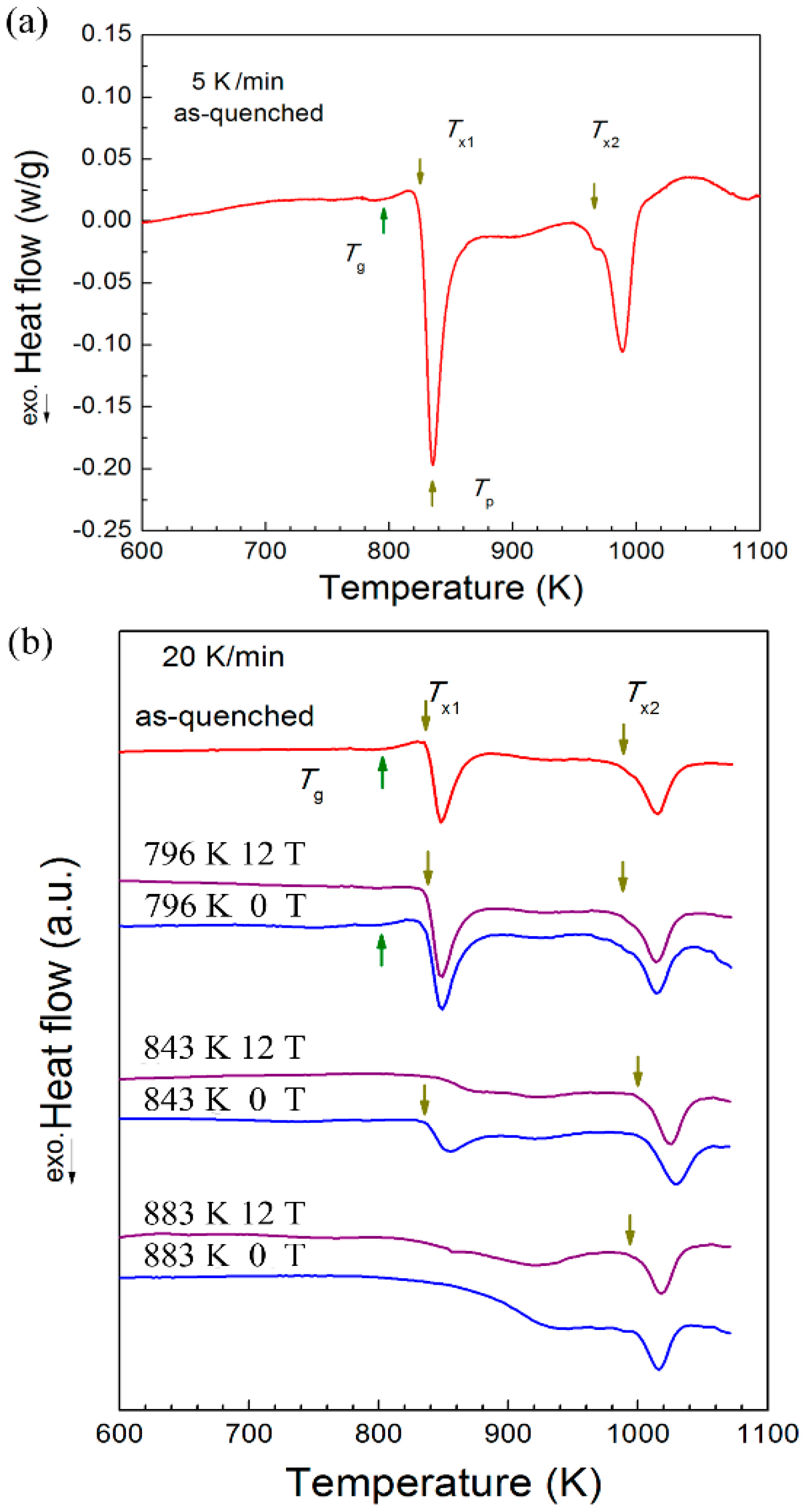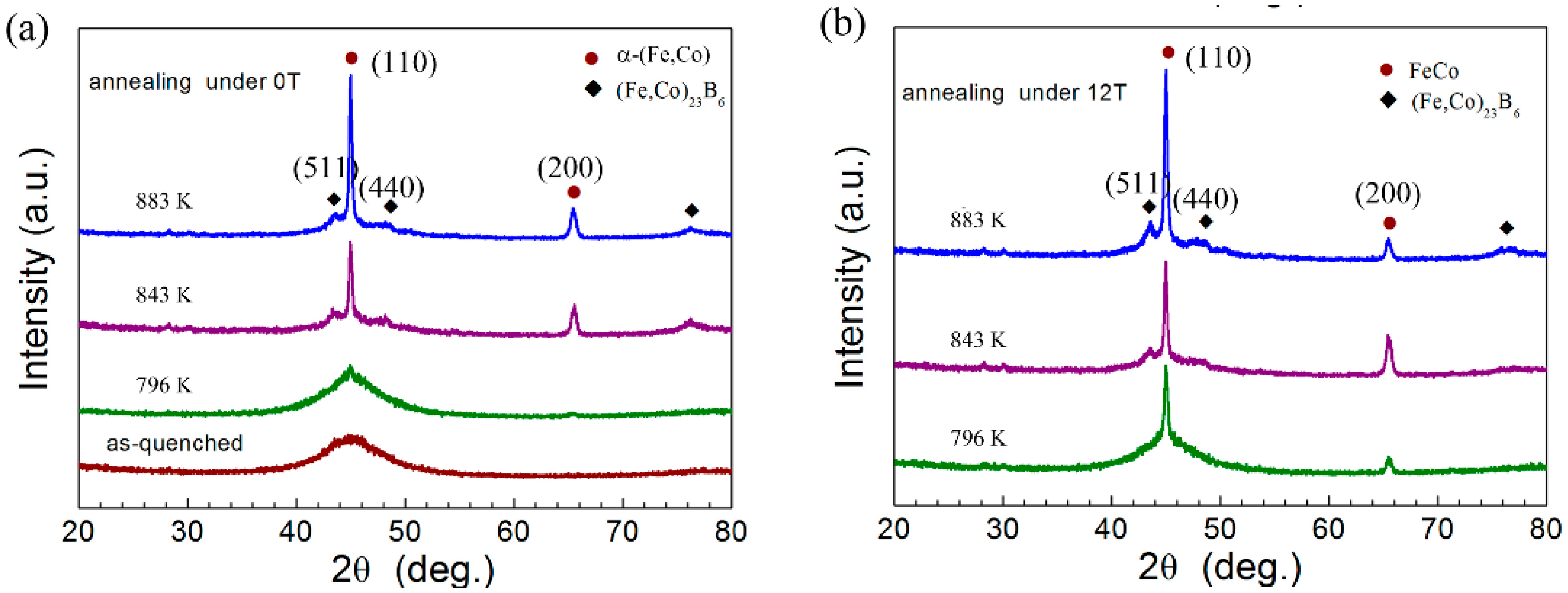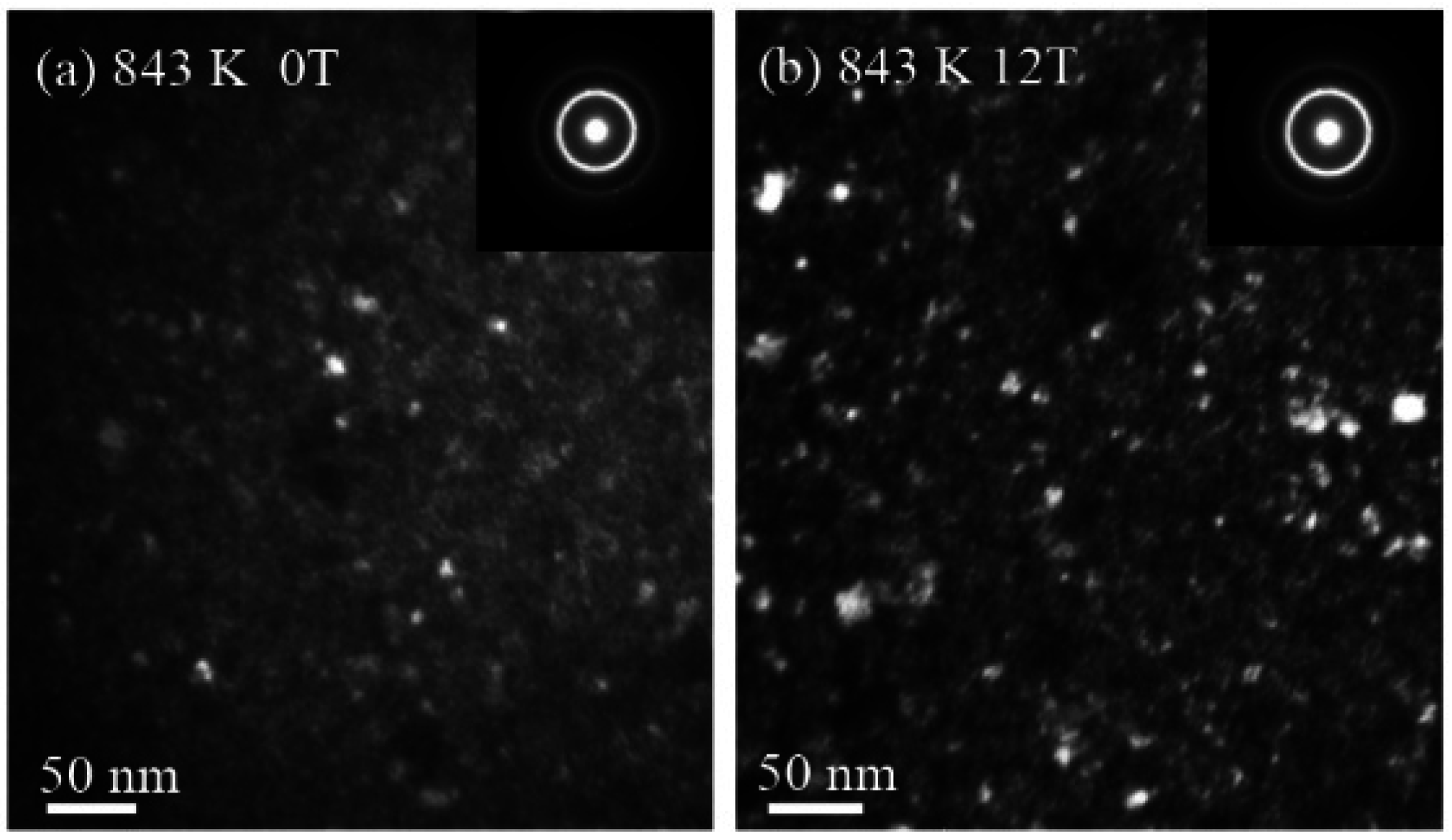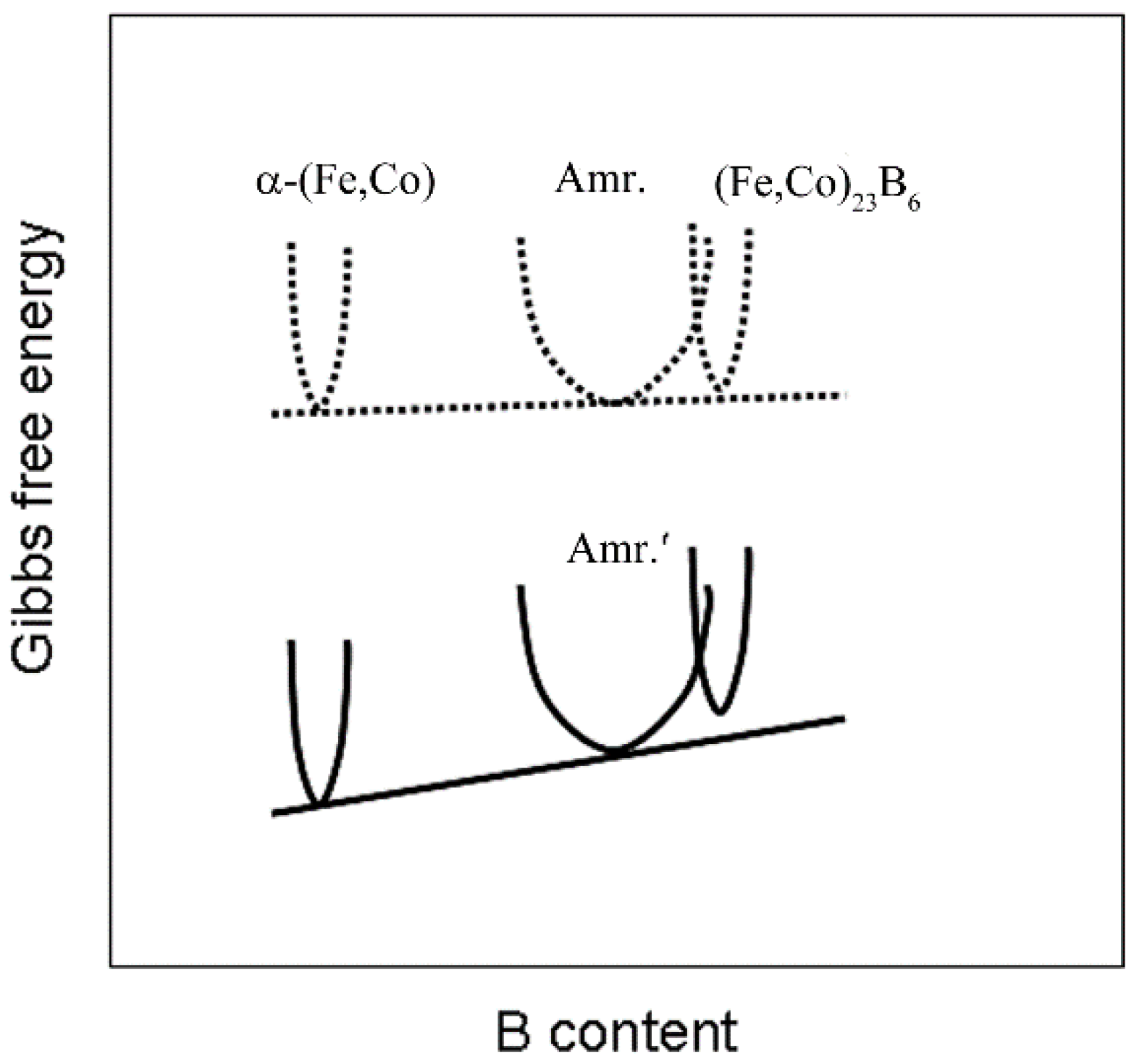The Effects of a High Magnetic Field on the Annealing of [(Fe0.5Co0.5)0.75B0.2Si0.05]96Nb4 Bulk Metallic Glass
Abstract
:1. Introduction
2. Materials and Methods
3. Results and Discussion
4. Conclusions
Acknowledgments
Author Contributions
Conflicts of Interest
References
- Gutfleisch, O.; Willard, M.A.; Brück, E.; Chen, C.H.; Sankar, S.G.; Liu, J.P. Magnetic Materials and Devices for the 21st Century: Stronger, Lighter, and More Energy Efficient. Adv. Mater. 2011, 23, 821–842. [Google Scholar] [CrossRef] [PubMed]
- Willard, M.A.; Daniil, M.; Kniping, K.E. Nanocrystalline soft magnetic materials at high temperatures: A perspective. Scr. Mater. 2012, 67, 554–559. [Google Scholar] [CrossRef]
- Shen, B.L.; Akiba, M.; Inoue, A. Excellent soft-ferromagnetic bulk glassy alloys with high saturation magnetization. Appl. Phys. Lett. 2006, 88, 131907. [Google Scholar] [CrossRef]
- Chang, C.T.; Shen, B.L.; Inoue, A. FeNi-based bulk glassy alloys with superhigh mechanical strength and excellent soft-magnetic properties. Appl. Phys. Lett. 2006, 89, 051912. [Google Scholar] [CrossRef]
- Han, Y.; Chang, C.T.; Zhu, S.L.; Inoue, A.; Louzguine-Luzgin, D.V.; Shalaan, E.; Al-Marzouki, F. Fe-based soft magnetic amorphous alloys with high saturation magnetization above 1.5 T and high corrosion resistance. Intermetallics 2014, 54, 169–175. [Google Scholar] [CrossRef]
- Suzuki, K.; Makino, A.; Inoue, A.; Masumoto, T. Low core losses of nanocrystalline Fe-M-B (M = Zr, Hf, or Nb) alloys. J. Appl. Phys. 1993, 74, 3316–3322. [Google Scholar] [CrossRef]
- McHenry, M.E.; Johnson, F.; Okumura, H.; Ohkubo, T.; Ramanan, V.R.V.; Laughlin, D.E. The kinetics of nanocrystallization and microstructural observations in Finemet, Nanoperm and Hitperm nanocomposite magnetic materials. Scr. Mater. 2003, 48, 881–887. [Google Scholar] [CrossRef]
- Mchenry, M.E.; Willard, M.A.; Laughlin, D.E. Amorphous and nanocrystalline materials for applications as soft magnets. Prog. Mater. Sci. 1999, 44, 291–433. [Google Scholar] [CrossRef]
- Flohrer, S.; Schäfer, R.; Polak, C.; Herzer, G. Interplay of uniform and random anisotropy in nanocrystalline soft magnetic alloys. Acta Mater. 2005, 53, 2937–2942. [Google Scholar] [CrossRef]
- Fernández Barquín, L.; Gómez Sal, J.C.; Gorria, P.; Garitaonandia, J.S.; Barandiarán, J.M. Crystal structure and magnetic behaviour of nanocrystalline Fe-Nb-Cu-Si-B alloys studied by means of in situ neutron diffraction. J. Phys. Condens. Matter B 1998, 10, 5027–5038. [Google Scholar] [CrossRef]
- Gorria, P.; Garitaonandia, J.S.; Barandiarán, J.M. Structural and magnetic changes in FeNbCuSiB amorphous alloys during the crystallization process. J. Phys. Condens. Matter B 1996, 8, 5925–5939. [Google Scholar] [CrossRef]
- Gorria, P.; Garitaonandia, J.S.; Perez, M.J.; Blanco, J.A.; Campo, J. Crystallization of Fe75Zr25 metallic glass: A two-step process involving metastable bcc-Fe and polymorphic transformation. Phys. Status Solid RRL 2009, 3, 28–30. [Google Scholar] [CrossRef]
- Ohodnicki, P.R.; Cates, N.C.; Laughlin, D.E.; McHenry, M.E.; Widom, M. Ab initio theoretical study of magnetization and phase stability of the (Fe,Co,Ni)23B6 and (Fe,Co,Ni)23Zr6 structures of Cr23C6 and Mn23Th6 prototypes. Phys. Rev. B 2008, 78, 144414.1–144414.13. [Google Scholar] [CrossRef]
- Chen, Y.M.; Ohkubo, T.; Ohta, M.; Yoshizawa, Y.; Hono, K. Three-dimensional atom probe study of Fe-B-based nanocrystalline soft magnetic materials. Acta Mater. 2009, 57, 4463–4472. [Google Scholar] [CrossRef]
- Zhou, Z.N.; Wu, K.M. Molybdenum carbide precipitation in an Fe-C-Mo alloy under a high magnetic field. Scr. Mater. 2009, 61, 670–673. [Google Scholar] [CrossRef]
- Li, X.; Ren, Z.M.; Fautrelle, Y.; Zhang, Y.D.; Esling, C. Morphological instabilities and alignment of lamellar eutectics during directional solidification under a strong magnetic field. Acta Mater. 2010, 58, 1403–1417. [Google Scholar] [CrossRef]
- Wang, Q.; Liu, T.; Gao, A.; Zhang, C.; Wang, C.J.; He, J.C. A novel method for in situ formation of bulk layered composites with compositional gradients by magnetic field gradient. Scri. Mater. 2007, 56, 1087–1090. [Google Scholar] [CrossRef]
- Zuo, X.W.; Wang, E.G.; Han, H.; Zhang, L.; He, J.C. Magnetic properties of Fe–49%Sn monotectic alloys solidified under a high magnetic field. J. Alloys Compd. 2010, 492, 621–624. [Google Scholar] [CrossRef]
- Zhang, Y.D.; Gey, N.; He, C.S.; Zhao, X.; Zuo, L.; Esling, C. Low temperature tempering of a medium carbon steel in high magnetic field. ISIJ Int. 2005, 45, 913–917. [Google Scholar] [CrossRef]
- Wang, X.D.; Qi, M.; Yi, S. Crystallization behavior of bulk amorphous alloy Zr62Al8Ni13Cu17 under high magnetic field. Scr. Mater. 2004, 51, 1047–1050. [Google Scholar] [CrossRef]
- Fujii, H.; Tsurekawa, S.; Matsuzaki, T.; Watanabe, T. Evolution of a sharp {110} texture in microcrystalline Fe78Si9B13 during magnetic crystallization from the amorphous phase. Philos. Mag. Lett. 2006, 86, 113–122. [Google Scholar] [CrossRef]
- Suzuki, K.; Herzer, G. Magnetic-field-induced anisotropies and exchange softening in Fe-rich nanocrystalline soft magnetic alloys. Scr. Mater. 2012, 67, 548–553. [Google Scholar] [CrossRef]
- Jia, P.; Wang, E.G.; Han, K. The effects of high magnetic field on crystallization of Fe71(Nb0.8Zr0.2)6B23 bulk metallic glass. J. Alloys Compd. 2013, 581, 373–377. [Google Scholar] [CrossRef]
- Hirata, A.; Hirotsu, Y.; Amiya, K.; Nishiyama, N.; Inoue, A. Nanocrystallization of complex Fe23B6-type structure in glassy Fe-Co-B-Si-Nb alloy. Intermetallics 2008, 16, 491–497. [Google Scholar] [CrossRef]
- Torrens-Serra, J.; Rodríguez-Viejo, J.; Clavaguera-Mora, M.T. Nanocrystallization kinetics and glass forming ability of the Fe65Nb10B25 metallic alloy. Phys. Rev. B 2007, 76, 214111. [Google Scholar] [CrossRef]
- Stoica, M.; Kumar, S.; Roth, S.; Ram, S.; Eckert, J.; Vaughan, G.; Yavari, A.R. Crystallization kinetics and magnetic properties of Fe66Nb4B30 bulk metallic glass. J. Alloys Compd. 2009, 483, 632–637. [Google Scholar] [CrossRef]
- Li, Z.Z.; Wang, A.D.; Chang, C.T.; Wang, Y.G.; Dong, B.S.; Zhou, S.X. Synthesis of FeSiBPNbCu nanocrystalline soft-magnetic alloys with high saturation magnetization. J. Alloys Compd. 2014, 611, 197–201. [Google Scholar] [CrossRef]
- Zhuang, Y.X.; Wang, W.B.; Han, B.T.; Wang, Z.M.; Xing, P.F. Crystallization behavior of Fe84B10C6 amorphous alloy under high magnetic field. J. Non-Cryst. Solids 2016, 432, 200–207. [Google Scholar] [CrossRef]
- Corb, B.W.; O’Handley, R.C.; Grant, N.J. Magnetic moments and bonding in Co-Nb-B alloy. J. Magn. Magn. Mater. 1983, 31, 1537–1539. [Google Scholar] [CrossRef]





| Annealing Condition | ΔH1 (J/g) | ΔH2 (J/g) | Ms (emu/g) | Hc (A/m) | Phase | |
|---|---|---|---|---|---|---|
| AMS | 57.9 ± 0.1 | 43.2 ± 0.1 | 133.2 ± 0.2 | 7.1 ± 0.1 | Amr. | |
| 796 K | 12 T | 50.5 ± 0.1 | 41.1 ± 0.1 | 134.4 ± 0.4 | 1.5 ± 0.2 | Amr. + α-(Fe,Co) |
| 0 T | 57.9 ± 0.1 | 40.1 ± 0.1 | 132.8 ± 0.5 | 3.3 ± 0.1 | Amr. + α-(Fe,Co) + (Fe,Co)23B6 | |
| 843 K | 12 T | 0 | 39.7 ± 0.1 | 133.3 ± 0.3 | 53.8 ± 0.4 | Amr. + α-(Fe,Co) + (Fe,Co)23B6 |
| 0 T | 21.6 ± 0.2 | 40.0 ± 0.1 | 130.7 ± 0.2 | 26.5 ± 0.3 | Amr. + α-(Fe,Co) + (Fe,Co)23B6 | |
| 883 K | 12 T | 0 | 35.5 ± 0.1 | 129.8 ± 0.2 | 56.5 ± 0.5 | Amr. + α-(Fe,Co) + (Fe,Co)23B6 |
| 0 T | 0 | 33.9 ± 0.1 | 133.2 ± 0.3 | 54.1 ± 0.4 | Amr. + α-(Fe,Co) + (Fe,Co)23B6 | |
© 2016 by the authors; licensee MDPI, Basel, Switzerland. This article is an open access article distributed under the terms and conditions of the Creative Commons Attribution (CC-BY) license (http://creativecommons.org/licenses/by/4.0/).
Share and Cite
Jia, P.; Wang, E.-g.; Han, K. The Effects of a High Magnetic Field on the Annealing of [(Fe0.5Co0.5)0.75B0.2Si0.05]96Nb4 Bulk Metallic Glass. Materials 2016, 9, 899. https://doi.org/10.3390/ma9110899
Jia P, Wang E-g, Han K. The Effects of a High Magnetic Field on the Annealing of [(Fe0.5Co0.5)0.75B0.2Si0.05]96Nb4 Bulk Metallic Glass. Materials. 2016; 9(11):899. https://doi.org/10.3390/ma9110899
Chicago/Turabian StyleJia, Peng, En-gang Wang, and Ke Han. 2016. "The Effects of a High Magnetic Field on the Annealing of [(Fe0.5Co0.5)0.75B0.2Si0.05]96Nb4 Bulk Metallic Glass" Materials 9, no. 11: 899. https://doi.org/10.3390/ma9110899





